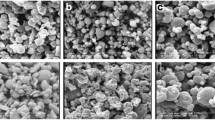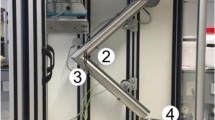Abstract
The distribution of oleic acid between Salbutamol base drug and the solvent in metered-dose inhalers (MDI's) has been investigated. The equilibrium surfactant concentration in the drug dispersions has been determined using a colorimetric method. The samples examined contained Salbutamol base drug particles and oleic acid dispersed in different propellant blends of freon 11 and 12. The maximum equilibrium concentration observed depended on the propellant blend used. The propellant blend and the distribution of the surfactant affected the dispersion stability. The effect of the surfactant is illustrated by the adsorption isotherm for oleic acid onto the Salbutamol particles. The results are correlated with zeta-potentials and particle size measurements made on similar systems in order to characterize the properties of surfactant stabilized MDI's.
Similar content being viewed by others
REFERENCES
H. Koelmans and J. T. Overbeek. Stability and electrophoretic deposition of suspensions in non-aqueous media. Discussion of the Faraday Society 18:52–63 (1954).
A. Doroszkowski and R. Lambourne. Effect of molecular architecture of long chain fatty acids on the dispersion properties of Titanium Dioxide in non-aqueous liquids. Discussion of the Faraday Society 65:252–263 (1978).
D. A. Wyatt and B. Vincent. Electrical effects in non-aqueous systems. Journal of Biopharmaceutical Science 3(1/2):27–31 (1992).
R. H. Ottewill and J. M. Tiffany. The adsorption of long chain acids onto rutile from n-heptane. Journal of Oil Colour Chemical Association 50:844–864 (1967).
D. H. Wheeler, D. Potente, and H. Wittcoff. Adsorption of dimer, trimer, stearic, oleic, linoleic, nonanoic and azelaic acids on ferric oxide. Journal of the American Oil Chemist's Society 48:125–128 (1971).
R. S. Drago and B. B. Wayland. A double-scale equation for correlating enthalpies of Lewis acid-base interactions. Journal of the American Chemical Society 20:3571–3577 (1965).
R. S. Drago, G. C. Vogel, and T. E. Needham. A four-parameter equation for predicting enthalpies of adduct formation. Journal of the American Chemical Society 17:6014–6060 (1971).
K. B. Sandström, P. M. Eriksson, and J. B. Rosenholm. Electrophoretic Mobility of Salbutamol Drug Powder in Mixed Propellant blend. Journal of Pharmaceutical Science 83(10):1380–1385 (1994).
R. R. Lowry and I. J. Tinsley. Rapid colorimetric determination of free fatty acids. Journal of the American Oil Chemists' Society 53:470–472 (1976).
M. A. Taylor and L. H. Princen. Fatty acids in solutions. In E. H. Pryde (editor) Fatty Acids. The American Oil Chemists' Society — Champaign, Illinois, 1979, pp. 195–198.
P. A. Sanders. Handbook of Aerosol Technology. Robert E. Krieger publishing company, Malabar Florida, 1987, pp. 165–187.
J. J. Kipling and E. H. M. Wright. Adsorption from binary of limited concentration range: Application of some fundamental concepts. Journal of the Chemical Society 855–860 (1962).
P. C. Hiementz. Principles of Colloid and Surface Chemistry. Marcel Dekker, INC., New York and Basel, 1986, pp. 353–425.
B. K. Sidhu, C. Washington, S. S. Davis, and T. S. Pureval. Electrophoretic properties of lactose and Salbutamol sulfate suspensions in halogenated solvents. Langmuir 9:839–843 (1993).
P. E. Kornebekke, I. D. Morrison, and T. Oja. Electrophoretic mobility measurements in low conductivity media. Langmuir 8:1211–1217 (1992).
I. D. Morrison. Criterion for electrostatic stability of dispersions at low ionic strength. Langmuir 7:1920–1922 (1991).
M. Kosmulsky and E. Matejevíc. Microelectrophoresis of silica in mixed solvents of low dielectric constant. Langmuir 7:2066–2071 (1991).
R. J. Pugh, T. Matsunga, and F. M. Fowkes. The dispersibility and stability of carbon black in media of low dielectric constant. 1. Electrostatic and steric contributions to colloidal stability. Colloids and Surfaces 7:183–207 (1983).
F. M. Fowkes, H. Jinnai, M. A. Mostafa, F. W. Andersen, and R. J. Moore. Mechanism of electrical charging of particles in nonaqueous liquids. American Chemical Society Symposium, Series 240, Washington DC, 1982, pp. 307–324.
A. Kitahara, M. Amano, S. Kawasaki, and K. Kon-no. The concentration effect of surfactants on zeta-potential in non-aqueous dispersion. Colloid and Polymer Science 255:1118–1121 (1977).
K. E. Lewis and G. D. Parfitt. Stability of non-aqueous dispersions. Transaction of the Faraday Society 62:1652–1661 (1966).
D. N. L. McGown, G. D. Parfitt, and E. Willis. Stability of non-aqueous dispersion. I. The relationship between surface potential and stability in hydrocarbon media. Journal of Colloidal Science 20:650–664 (1965).
Author information
Authors and Affiliations
Rights and permissions
About this article
Cite this article
Eriksson, P.M., Sandström, K.B. & Rosenholm, J.B. The Distribution of Oleic Acid Between Salbutamol Base Drug and Different Propellant Blends. Pharm Res 12, 715–719 (1995). https://doi.org/10.1023/A:1016263610165
Issue Date:
DOI: https://doi.org/10.1023/A:1016263610165




